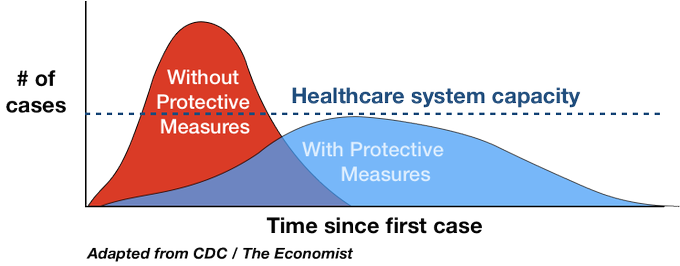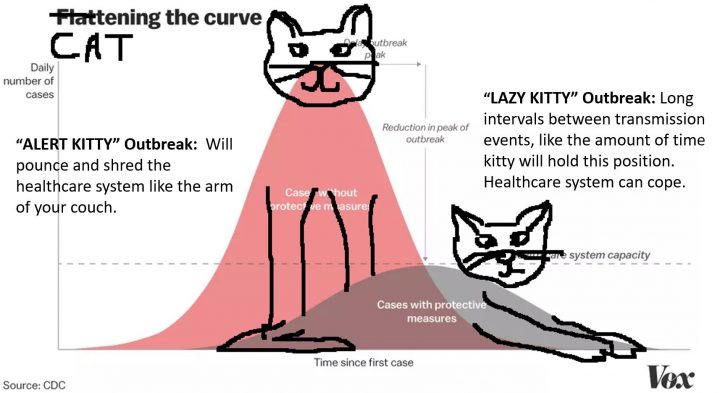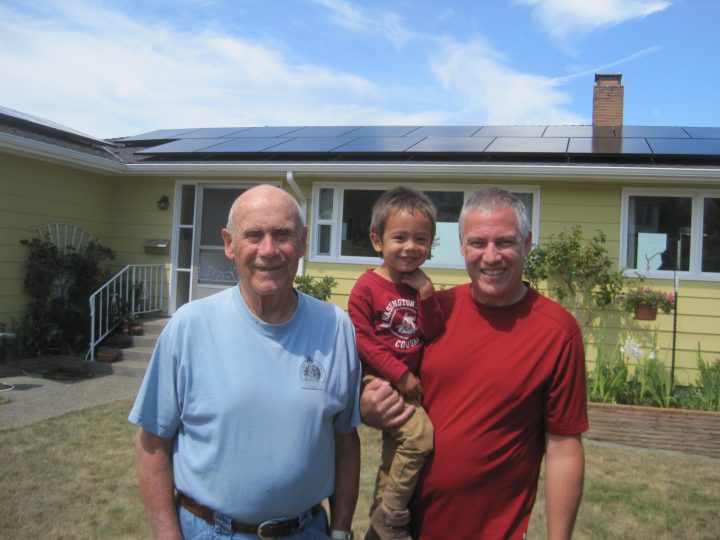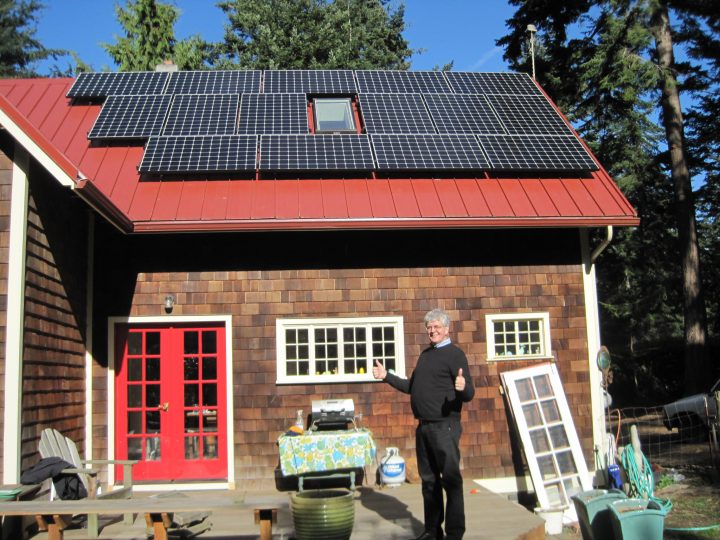As I take a deep calming breath, and anticipate the day we bring our crew back to work and resume installing solar arrays, I am thinking about opportunities to do things better societally, not just resume exactly as we have done until now. In the US, we strive to balance rewarding ingenuity and hard work, removing barriers for people to better themselves, while also taking care of those who struggle because of lack of access to opportunity, discrimination, disability, ill-health, or just plain bad luck. Achieving this balance is one of the ideals my country holds. That being said, we all recognize there is, and has always been, a significant inertia in the reality that the rich get richer, and the rest are sometimes left behind. Removing the unfair advantages brought by wealth and privilege should be one of our collective goals when examining any policy, federally or locally.
So what does this mean in terms of access to clean energy? There are two unfortunate examples of our failure to do this on my mind from recent conversations.
A friend from Bainbridge Island lives in a condo in downtown Winslow. She works within 20 miles of her house and visits her parents here in Port Townsend a few times a month. It is rare for her to need to drive more than 100 miles in a day. She wants to trade in her existing aging car for a newer model, and she wants an electric vehicle for her and her young child. I am a fan of Nissan Leafs, but there are now many excellent choices across a spectrum of price and range, and there is no doubt it would save her lots of money on gasoline (and decrease her personal carbon emissions.). The challenge is that because she is not a homeowner, she does not have access to a dependably available EV charging location. There are a couple of EV spots for recharging within a few blocks of her house, but even that distance is inconvenient when she has her child and perhaps groceries in the winter. Ideally she needs the dependability of being able to charge when she needs to, close to home. She has been doing a little on-the-ground research and sees that the equipment and spots are often occupied by another EV when she would park. She does not feel comfortable with the prospect of having to park elsewhere when she gets home, and having to go back out to check the availability of the charging spot and move her car in the evening so its is full again in the morning. Her workplace has one EV spot in the garage, but it also is often occupied by customers or other employees.
This is an example of how increasing our public investment in EV Service Equipment infrastructure, and incorporating requirements for EVSE spaces in new development would help provide fair access to clean electric vehicles to people who are not currently homeowners. These are important policies we need to adopt now, since we have not already done so. It is past time for this in my thinking.
Regarding the Community Solar Project here in Port Townsend, it appears that the current application submitted by Jefferson PUD to build a community solar array will not be approved in time for the project to come to fruition. This is a great shame for many reasons. Primarily it was the opportunity to utilize generous state funds for projects just like this in a way that would benefit our community, especially those who don’t own their own homes. Are you seeing a trend here? Homeowners that want access to clean solar energy generally have it installed on their own roof, provided it is not too shady. Even in the case that someone doesn’t have immediate access to the cash for these projects, there is a significant federal tax credit, and also several sources of local credit unions offering low interest energy efficiency loans. Access to solar is much more difficult for a renter or condo-dweller since they don’t own their own roof on which to install solar. Community solar projects are common sense and economical ways to make the benefits of solar available to everybody in small slices. People who are able to participate in community solar projects enjoy a long term economic benefit; these projects can help individuals and households hedge against rising energy costs while participating in the clean energy future most of us envision. From my observation, it appears that some neighboring homeowners had objections to this project on an aesthetic basis, and successfully have prevented the project through active obstruction through the public permitting process. The concept that an existing utility sub-station might not be an appropriate for a ground-mounted solar array is mind-boggling to me, but apparently the city staff is sympathetic to these views of some neighboring homeowners. I am making a strong statement here, which would surely be vigorously disputed by some. I would welcome respectful communication, and will gladly admit if I can be shown to be wrong. The missed opportunity of about $110,000 of state funds, and our city’s failure to nurture this project is a loss for our community in many ways.
The pandemic we are currently experiencing, the concern over potential loss of lives, and our necessary short-term economic pain to try to prevent the worst losses, are bringing new perspectives to our values. What do we truly deem important for our future? The challenge of carbon emissions and the opportunities of cleaning our energy portfolio have not gone away while we have focused on more immediate concerns. The past does not have to determine our future. What steps can we take to build the world we want to emerge from this time of quiet disruption? How can we make clean energy technology and its benefits available to all?
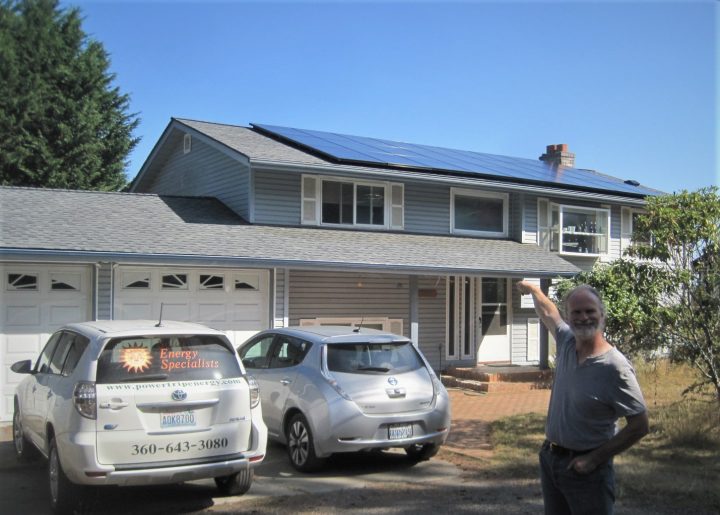
Leaf and RAV4EV able to recharge from homemade solar electricity in Port Townsend, 9.5 kw SunPower array on Jefferson PUD grid.
by Andy Cochrane | Apr 9, 2020
Taking Care During An Emergency – We are Available to You via Phone and E-mail – Some Thoughts on Emergency Preparation
During the epidemic our office is closed and installations are temporarily suspended. We are working via phone and email from home, and we are able to perform virtual site evaluations and proposals. Our crew is at home taking care of their families, and eager to resume our solar installations. Please give us a call or send an email to learn what you can do at your home or business in terms of solar. Please be prepared to send us a copy of your power bill, and photos of your electrical service panel. The house and roof can be reviewed using Google Earth and some other online tools.
For all of us, our health and safety is paramount at this moment. We are grateful for those in essential jobs who are working for all our benefit – thank you to them.
Many years ago, I came across a theory of a continuum of disasters, that may be useful to consider when preparing for the worst and hoping for the best. The theory that one one end of the continuum are small emergencies – that would affect you and a very small number of people around you, would last a relatively short time, and which are relatively easy to prepare for. For example individual disasters like this for example would be a job loss, or perhaps neighborhood-wide if a car hit a power pole and knocked out. Disasters on the other end of the spectrum affect a large number of people in a large geographical area, are long-lasting, and can be difficult and expensive to prepare for. In the past, I would always think of Hurricanes Katrina and Sandy as examples, involving long term power outages, perhaps loss of clean municipal water supplies, and perhaps physical danger and structure collapses. The current Covid-19 pandemic surely is at the very serious side of the spectrum. The odd thing about this disaster is that for many of us, the most difficult effect so far is staying home, and for many of us there is loss of income. If we have successfully avoided infection and illness for ourselves and our loved ones at this point, there is no immediate loss of physical safety or discomfort, no loss of food, power, water, or shelter. At this point, we are all affected by it, and it sadly appears that the disease will become so widespread that we will all know people seriously affected.
I bring up this concept of disaster continuum as a framework for how we can think about how to prepare for such events. It seems prudent to take the steps initially to prepare for the more likely and smaller disasters, while working your way up to more robust systems. Initial thoughts go to one gallon of stored water per person per day, food for a month, some emergency cash on hand, first aid supplies, and none of us will probably ever forget the grocery store shelves bare of toilet paper and hand sanitizer. Providing your own electricity is a little higher up the spectrum, and should be considered after taking care of several other basics. We continue to receive an increasing number of inquiries about batteries as a way of using your solar array in the event of a power outage, and we have been installing more of these systems as wall-mounted residential scale lithium batteries are becoming more common. During this particular event so far however, we have seen that stocking up on basic supplies has been the most useful preparations, in addition to doing everything you can to maintain a healthy immune system, which is always a good idea. At my house it means focusing on the garden and orchard, and adding some new chicks to the small (and aging) flock of egg-laying hens.
Last year at our home, we replaced our small lead acid battery with a larger lithium battery from LG. I say larger in terms of capacity only – it is actually 8 times the usable capacity, while being physically smaller. We have only noticed one brief outage in the time this new battery has been present, but it is a significant part of our overall preparedness. Our 10 kwh LG lithium battery backs up our refrigerators, chest freezer, kitchen and living room lights and receptacles, and the small circulating pumps on our solar thermal collectors and for our radiant floor heat. The battery is recharged by the solar array on the roof of the house, and so will be recharged during an outage. In the winter, we would have to be very conservative with our usage to stay within the amount of energy our array makes during winter months. In the summer, the array would be making more energy than we could use or store.
As a company, our primary focus is helping our clients make clean energy with grid-tied solar (without batteries), which is good economics, a good investment in the home, and good for the environment. For some people, batteries are a good companion technology, though the benefits are in terms of resilience and preparedness, not easily quantifiable environmental or economic benefits.
We look forward to hearing from you, and to getting back up on the roof as soon as we are able – in the meanwhile, stay safe and stay healthy!
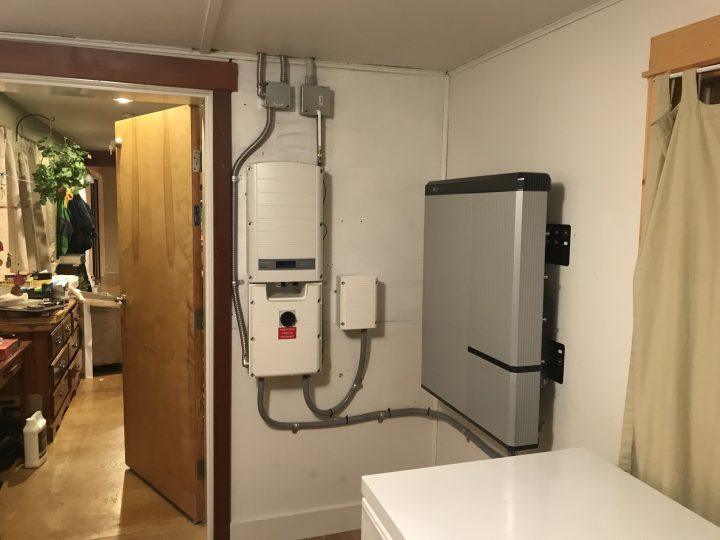
10 kWh LG lithium battery and SolarEdge StorEdge inverter
by Andy Cochrane | Mar 31, 2020
Here at Power Trip Energy, we are in the same situation as everybody else – concerned for the health of our employees, families, clients, and community. We are reading the news, reacting to event closures, and making sure everyone performs the best safest practices to prevent illness in ourselves and others. Immediately relevant is the cancellation of two home shows this weekend, and since cancellation was was not required, and because it surely represents a loss of revenue and time spent, we appreciate these decisions being made by KONP in Port Angeles and the Kitsap Builders Association. It is not the right time to conduct an event like a home show.
Since the nature of our work is generally outdoors, we are thankful to be proceeding with solar installations on regular schedule, while in the office, we are being especially clean and considerate of each other.
I love graphs, so I want to share a couple you have probably seen, which help me to understand the nature of the challenge ahead of us. In regards to statistically tracking what is known about the virus in the US, the Center for Disease Control site is simple and helpful. As of Friday March 13, yes, it appears we are on the upward curve as predicted. Check the bar graph titled “COVID-19 Cases in the United States by date of illness onset, January 12, 2020 to March 12, 2020 at 4pm ET (n=792)**” at https://www.cdc.gov/coronavirus/2019-ncov/cases-in-us.html
The reasonable question is when we will see leveling and what this curve will eventually look like over time. The “Flattening the Curve” originally from the CDC in 2007, and updated for this epidemic by Drew Harris, helps us understand the benefits of suppressing the curve as much as possible, in order to preserve as much health care capacity for those who need it most.
Yesterday, I got a much-appreciated smile when a friend shared a “Cattening the Curve” graph, encouraging us to be lazy kitties, stay home, and get some rest, thereby helping to flatten the curve, and keep the rate of illness within the capacity of our health care system to handle. Nicely done, Anne Marie Darling
https://twitter.com/amdar1ing/status/1237880129575157760?s=19Please take a moment to take care of yourselves, your family, and neighbors. We are here for you if you also want to take this moment to talk about clean solar energy.
by Andy Cochrane | Mar 13, 2020
It is disappointing, but we agree this is the right decision. More about flattening the curve tomorrow!
by Andy Cochrane | Mar 12, 2020
Kudos to the Jefferson PUD for listening to their constituents and pursuing some sensible renewable energy generation. By taking advantage of a soon-expiring state program incentivizing community solar, the PUD will harvest some of our local sunshine, make some of its own clean power, and make available an opportunity to invest in solar for folks who may not have their own sunny roof or the ability to install a full array for themselves. By purchasing shares in the Community Solar Array, Jefferson County rate-payers would be able to see the benefits on their own bill for their fraction of ownership of shares in the large array.
Dana Roberts, may he rest in peace, was a local clean energy activist and a PUD commissioner before our PUD became an electricity provider and when our county was still served by the Investor-Owned-Utility PSE. Dana was involved in 2008’s Proposition 1 campaign in which the public vote gave our PUD the authorization to become our own electric utility, negotiate terms with PSE, and purchase their assets. This was a truly remarkable campaign and event, and Dana’s knowledge and tenacity were invaluable resources for our community. Apart from that Dana was a lover of good stories and dark beer, with a dash of revolutionary flair.
It is appropriate that the project at the PUD substation on Kearny St in Port Townsend will be named the Dana Roberts Community Solar Array.
Our company has been privileged to install the community solar array on Washington St in Sequim for Clallam PUD, and also the small community solar array at the Jefferson Airport for the Jefferson Solar Group. With the support of the current state program, projects like this make economic sense and give access to solar to everyone.
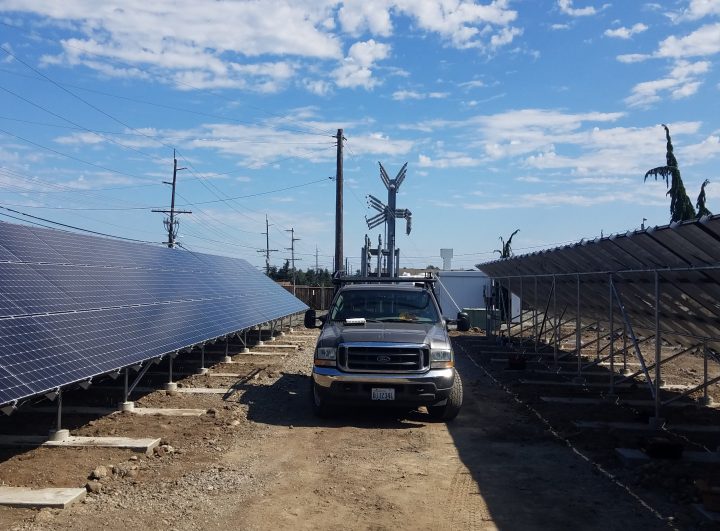
Clallam Community Solar Array, Sequim, WA
30 KW SunPower, Sept 2019
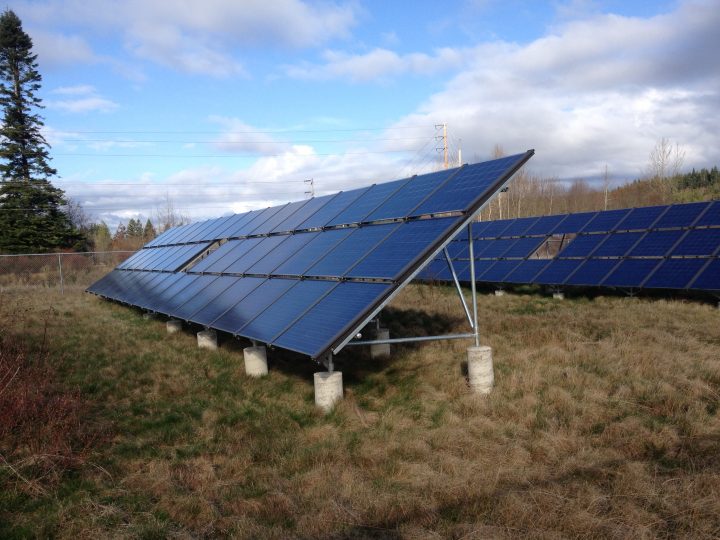
Community Solar Array, Jefferson Intl Airport, Port Townsend, 17 KW Silicon Energy, February 2011
by Andy Cochrane | Jan 28, 2020
We have enjoyed a 30% federal tax credit for just over 10 years. Sadly this tax credit begins to decrease beginning Jan 1, 2020. For the year 2020, the federal tax credit will be 26%, and in 2021 will be 22%, before the residential Investment tax credit disappears.
At this point, we can no longer make any new commitments to install systems prior to the end of December. We will try to get as many done this year as possible, but our schedule is near full, and we are subject to weather, holidays, and short days this time of year. For customers who sign contracts and provide deposits prior to November 30, if we do not get your project installed by the end of December, we will offer a 6% discount. This is a good deal for those customers as they will recognize a lower overall project cost, and because a portion of that savings is a discount, that means a lower transaction cost initially, rather than waiting for the tax credit next April 15. As we naturally get a lower solar output during the winter, the difference in production based on a January installation versus a December installation is the least significant.
So, if installing solar on your home is something you have considered doing “someday”, perhaps today is your best “someday.” We look forward to hearing from you and installing solar on your home.
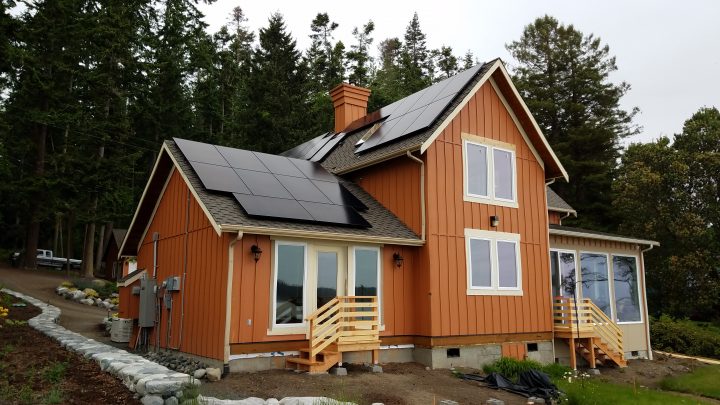
9.5 KW SunPower Array, Sequim Bay, July 2019
by Andy Cochrane | Oct 14, 2019
Pacific Gas & Electric’s rolling outages are amazing to see occuring, and are frightening for many experiencing them. Up to 700,000 people have been without grid electricity last night and today due to planned outages. I have friends in Sonoma who have experienced recent wildfires caused by PG&E’s negligence and lack of system maintenance, whose nerves are on edge due to the forecast of high wind and dry conditions. Their anxiety is compounded at the moment by these outages, even though they are preventative measures attempting to avoid the wildfires we have seen in the last few years..
https://www.sfgate.com/weather/article/PGE-power-shutoff-phase-two-Bay-Area-14506358.php
The underlying problem is the lack of maintenance by PG&E on their transmission system. This corporation has a history of taking the profits while socializing the risks and losses. As utilities are state supported monopolies, some of the responsibility lies with the California Public Utilities Commission. Unfortunately PG&E’s bankruptcy filing, questions surrounding that, and the plunge in share price does not bode well for the situation improving in the coming years.
https://www.latimes.com/business/story/2019-10-09/pge-bankruptcy-reorganization-plan-judge
This is a situation wherein a grid-tied solar pv system with back-up batteries would prove itself very useful. While batteries are expensive, homeowners who have spent the money are surely grateful at this moment. While we do not have these particular issues at the moment here in Washington, this is a cautionary event from which we can learn.
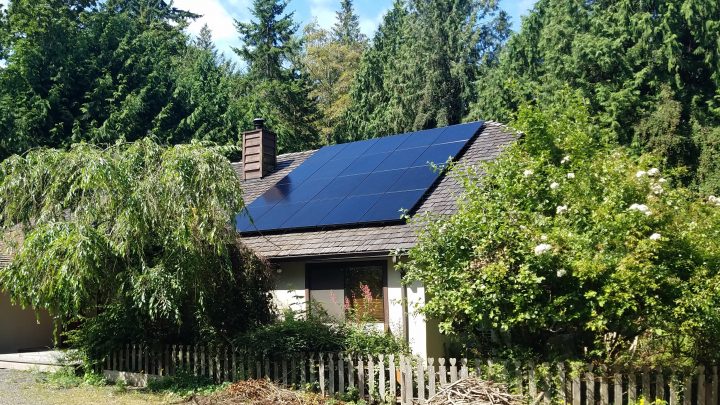
9.8 KW SunPower Solar PV, on PSE grid, Bainbridge Island, July 2019
by Andy Cochrane | Oct 10, 2019
Clallam PUD’s first Community Solar Array is operational and shares are fully sold out right on schedule. Please take a moment to celebrate, then you can feel free to inquire about subsequent phases. Thank you to Clallam PUD, to the Washington State legislature that made the program possible through Community Solar laws, and to all the individuals who have made this project a success. We are honored to be able to perform this meaningful work. To learn more, visit www.clallampud.net/communitysolar/
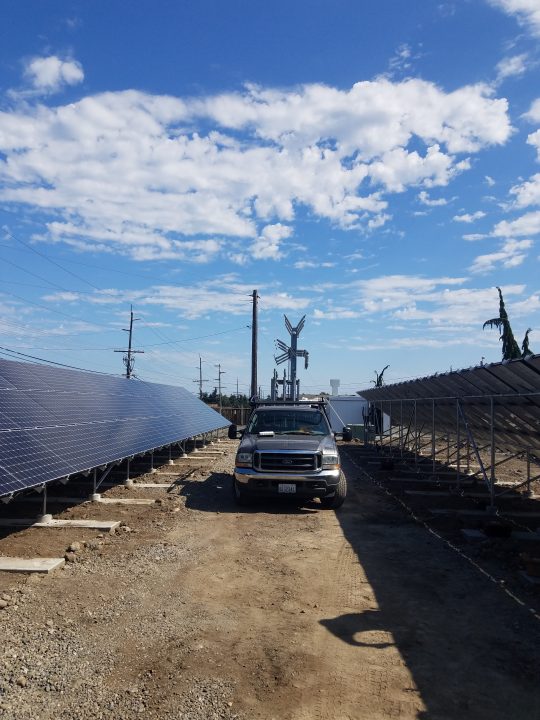
Clallam Community Solar Array in progress, Sept 2019
by Andy Cochrane | Sep 25, 2019
We have recently had a conversation with someone adversely affected by an unreliable contractor. I have been hearing sad tales like this during the entire 16 years we have been in business – these stories seem to come in waves. Most of these unfortunate events could be avoided by doing a little research and talking to existing happy customers and looking at a company’s track record. Unreliable companies rarely make it two years. While the fact that a company is new should not prevent you from working with them, you should be much more careful with a new company.
I will be forever grateful to Mr Lee Doughty who wrote me a large check in December of 2002, when this solar company was just a gleam in my eye. The trust he placed in me will always be appreciated and cherished. I would hate to think that my lack of other existing customers at the time would have prevented him from working with us – how is a small company supposed to get their first customer otherwise?
Support for earnest young start-ups aside, please do your research when hiring a solar contractor. This goes for any trade, but something about solar seems to attract companies that take advantage of a customer’s good intentions and enthusiasm with some gee-whiz marketing.
Here are some Yelp reviews that collectively tell a distressing story. https://www.yelp.com/biz/offset-solar-liberty-lake Of note, we don’t pay Yelp for our listing, I’m not sure if reviews can be left if we don’t pay for their service, however for existing customers read this and use Yelp (you need an account to provide review) are so motivated, we would appreciate a Yelp review or two or three.
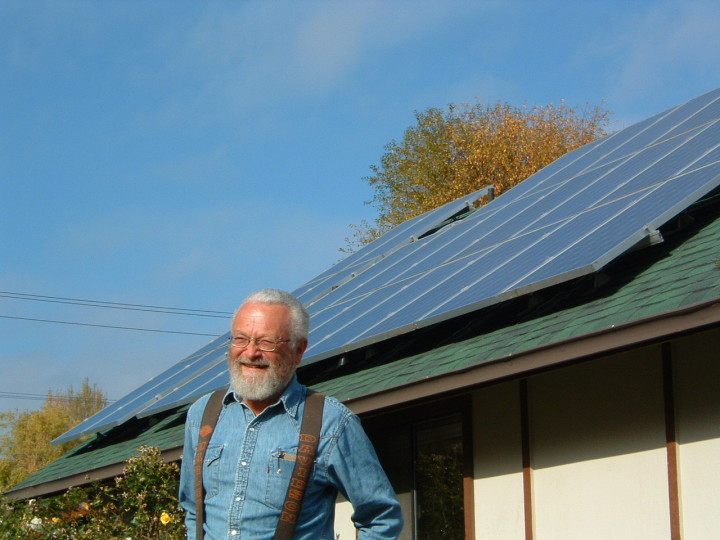
In 2002 Lee was a Solar Pioneer! In 2006, he enlarged his array and had the biggest one in town for a while.
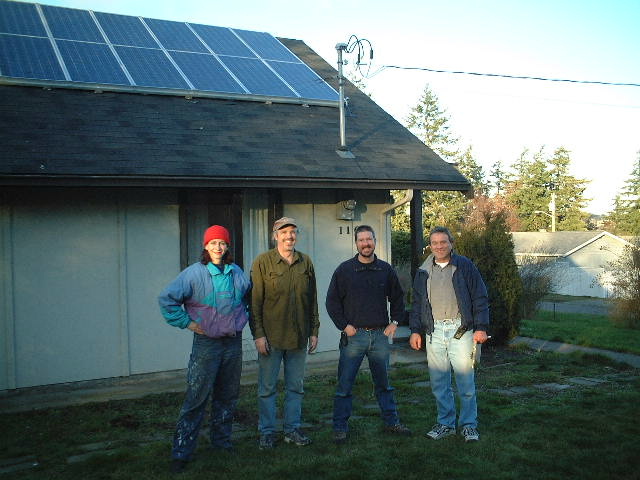
Prior to becoming electrical contractors in 2004, we worked with Puget Sound Solar to install our projects. Ara, Jeremy, Andy, and Emil at Jefferson County’s first Grid-tied PV installation, February 2003.
by Andy Cochrane | Sep 5, 2019
Wood MacKenzie recently published a study outlining the specific steps that would need to be taken in the next 10 years in order to accomplish a fully renewable energy grid here in the United States. Their article can be accessed here https://www.woodmac.com/news/feature/deep-decarbonisation-the-multi-trillion-dollar-question
The price tag of this ambitious endeavor including grid-level storage and eliminating nuclear plants is $4.5 trillion. This figure is not unattainable, there are several ways to put that into perspective. It is roughly equal to the annual federal budget. It is roughly equal to what we have spent on the “War on Terror” since 2001. It is $165 per household per month over the next 10 years.
Currently about 30% of our domestic energy use is through the electrical grid. The job of going 100% renewable on the electric grid is also made more challenging if we can rapidly shift the 30% of the energy we use for transportation away from nearly all petroleum to nearly all electricity. To maintain perspective, we find it helpful to review the Lawrence Livermore Labs energy charts, recently updated for 2018, see below.
The economic benefits of such an investment would be tremendous. As with solar on rooftops, once the investment is made, the ongoing cost of energy is very, very low (some people say “free”, I don’t agree.) The real world benefits of such a move would be to remove out electricity sector’s contribution to pollution both in terms of carbon, and the smog from nitrogen oxides, and sulfur, mercury and other poisonous emissions from fossil fuel consumption. There is no doubt in my mind that this is a goal we must pursue as quickly as possible, for many reasons.
Of note, Washington’s Gov Jay Inslee shares our perspective and has a very high energy literacy. He has a detailed and credible plan to implement much of what the Woods Mackenzie report outlines, while also analyzing the job creation benefits at the same time. It is worthwhile to take a close look at Gov Inslee’s vision here https://jayinslee.com/issues/evergreen-economy
While these national policy goals are important to consider, we prefer to spend our days installing solar on rooftops here on the Olympic Peninsula. It is something that we can feel good about every day, knowing we are helping our clients save money, decrease their contribution to pollution, and take steps towards a cleaner future.

by Andy Cochrane | Jun 28, 2019


